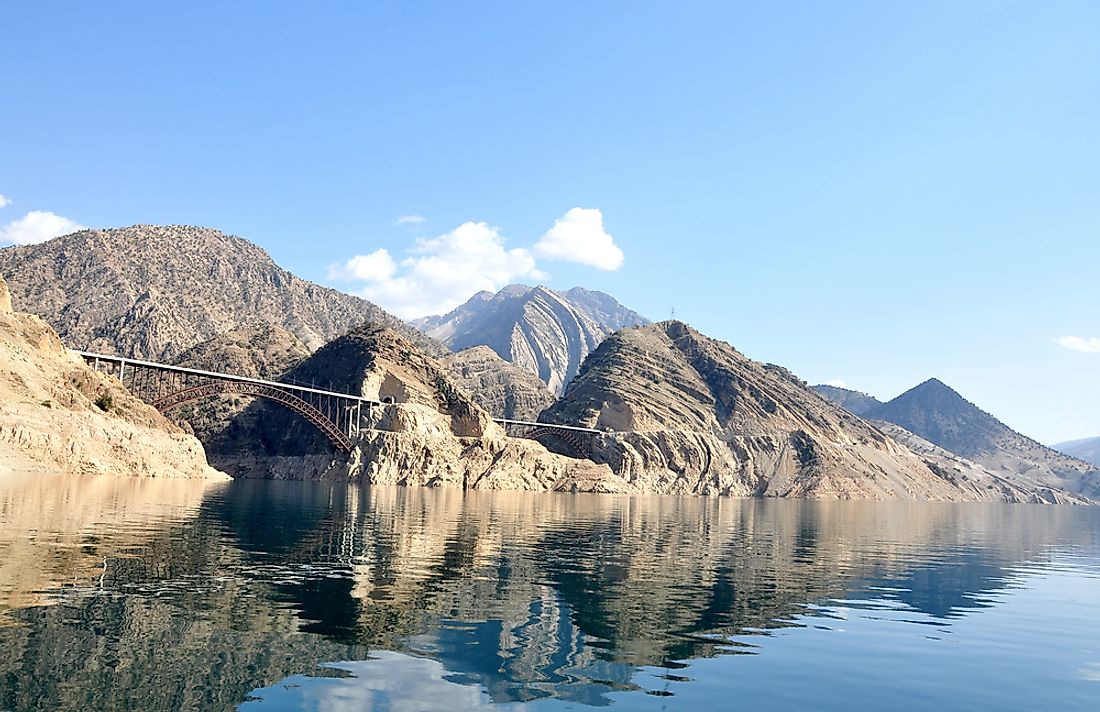Longest Rivers In Iran

Iran is home to a vast extended network of rivers, most of which originate in the mountainous regions and drain into interior basins. Most Iranian rivers are seasonal in flow, relatively short in length, and shallow in depth. Of Iran's major rivers, five flow into the Persian Gulf, these being the Dez, Karkheh, Karun, Diyala, and Lower Zab Rivers. Three, the Aras, Sefid Rud, and Atrek Rivers, flow into the Caspian Sea. Two others flow into smaller inland basins, namely the Zayanderud and Aji Chay.
Economic Significance
Iranians have used their rivers to allow for the irrigation of their agricultural lands since ancient times. Modern dams on the Ab-e Dez, Karkheh, Karun, Sefid Rud, and other rivers provide irrigation to ever larger agricultural regions, and also generate hydroelectricity for the countries steel companies, oil refineries, power plants and other industries. The Karun River is Iran's only permanently navigable waterway, and it has been an important commercial waterway ever since oil was discovered in the region. The Sefid Rud and Diyala River Valleys are also important trade routes. The Sefid Rud River is notable for its massive quantities of fish, especially sturgeon and Caspian trout.
Cultural Importance
Many Biblical scholars believe that the Karun River was one of the four rivers of the Garden of Eden. Archaeological evidence confirms that this area was an important area for early human hunter-gatherers, as well as groups of Neanderthals, and most likely the site of initial human domestication of plants and animals. In the Seventeenth Century, a scholar named Shaikh Bahai designed and built a system of canals to distribute water from the Zayanderud to the desert city of Isfahan. This boosted population growth and the economy, made Isfahan an influential center and green oasis in the middle of the desert.
Territorial Disputes
Three rivers run along long stretches of Iran's international boundaries. The Aras River borders Armenia and Azerbaijan, the Atrek River borders Turkmenistan, and the Shatt al Arab shares a border with Iraq. Additionally, five countries, including Iran, share the Caspian Sea, the world's largest inland body of water. These landmarks have been the sites of territorial disputes throughout recorded history. In 693 BC, the Assyrian empire fought the Elamites of southern Iran in the Battle of Diyala River. More recently, following the Russo-Persian wars of the Nineteenth Century, the Aras River was chosen as the border between the Russian Empire and Quajar Iran. The Atrek River formed a border between Iran and the Soviet Union (USSR) during the Cold War. During the Iran-Iraq War of the 1980s, Iranian forces stopped the early Iraqi advance at the Karun River.
Habitats and Biodiversity
River valleys are characterized by water-loving plants and marshy areas, which were prone to malarial outbreaks, before irrigation dried out the areas. Foothill zones and plains tend to be heavily cultivated along riverbanks. Water from Aji Chay is alkaline due to passing from the lands with high mineralization, although there is a project under development to divert the river's course away from alkali land.
Environmental Threats
Dams, a means to provide irrigation and hydroelectric power in some areas, have had disastrous effects on others. In 2009, three districts of the Basra province in southern Iraq were declared disaster areas because of Iranian dams on the Karun. The new dams caused high levels of salinity in the area, which destroyed farms and threatened livestock. Civilians were forced to evacuate. Dams on some rivers have had a significant effect on the sediment makeup and the ecology of the river, negatively impacting the nation's fisheries. Damming has caused submersion of numerous archaeological sites of significant historical value, and many once-permanent rivers have now become only a trickle, or disappear completely, during the dry season.
The Longest Rivers In Iran
| Rank | Longest Rivers In Iran | Total Length |
|---|---|---|
| 1 | Aras | 666 miles (shared with Turkey, Armenia, and Azerbaijan) |
| 2 | Karun | 590 miles |
| 3 | Karkheh | 559 miles |
| 4 | Sefid-Rud | 416 miles |
| 5 | Atrek | 416 miles |
| 6 | Diyala | 277 miles (shared with Iraq) |
| 7 | Lower Zab | 249 miles (shared with Iraq) |
| 8 | Dez (Coprates) | 249 miles |
| 9 | Zayanderud | 249 miles |
| 10 | Aji Chay, (Talkhe Rud) | 165 miles |











